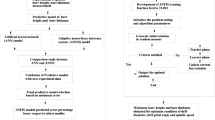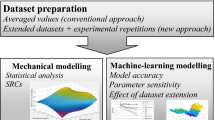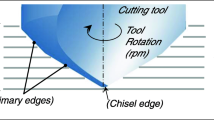Abstract
Tool wear and borehole quality are two critical issues for high precision drilling processes. In this paper, several drilling experiments in terms of different drilling parameters and drill bit with and without coating are conducted according to the Taguchi orthogonal arrays. Thrust force and moment were measured during the drilling process. The cutting edge radius depending on the wear, roughness and roundness of the borehole were also aquired. By combining the experiment dataset with the expert knowledge, a Bayesian prediction network of tool wear radius, surface roughness and borehole roundness is established through structure learning and parameter learning algorithms based on GeNIe, a disposable software to create Bayesian networks. Up to \(89\,\%\) accuracy were achieved using this approach. The research described in this paper can provide a new approach to multivariate prediction and parameter optimization in drilling.








Similar content being viewed by others
Abbreviations
- d :
-
Diameter in mm
- f :
-
Feed rate in mm/rev
- r e :
-
Cutting edge radius in \(\mu \)m
- v c :
-
Cutting speed in m/min
- F z :
-
Thrust force in N
- M c :
-
Drilling moment in Ncm
- R :
-
Roundness in \(\mu \)m
- Ra :
-
Roughness in \(\mu \)m
- \(\theta \) :
-
Probability
- \(\textit{L}(\theta )\) :
-
Likelyhood
- AI:
-
Artificial intelligence
- ANN:
-
Artificial neural network
- ANOVA:
-
Analysis for variance
- BDe:
-
Bayesian Dirichlet equivalence
- BN:
-
Bayesian network
- BPNN:
-
Backpropagation neural network
- BS:
-
Bayesian search
- CPT:
-
Conditional probability table
- DAG:
-
Directed acyclic graph
- EM:
-
Expectations maximum
- GA:
-
Generic algorithm
- HC:
-
Hill climbing g algorithm
- MLPNN:
-
Multilayer perceptions neural network
- NB:
-
Naive Bayes
- RBFN:
-
Radial basis function network
- RBFNN:
-
Radial basis function neural network
- RSM:
-
Response surface methodology
- TAN:
-
Tree-augmented Naive Bayes
- TCP:
-
Tool center point
- WPT:
-
Wavelet packet transform
References
Uçak N, Çiçek A (2018) The effects of cutting conditions on cutting temperature and hole quality in drilling of Inconel 718 using solid carbide drills. J Manuf Process 31:662–673
Biermann D, Bleicher F, Heisel U, Klocke F, Möhring H-C, Shih A (2018) Deep hole drilling. CIRP Annals 67(2):673–694
Oezkaya E, Beer N, Biermann D (2016) Experimental studies and CFD simulation of the internal cooling conditions when drilling Inconel 718. Int J Mach Tools Manuf 108:52–65
Fernández-Pérez J, Cantero JL, Díaz-Álvarez J, Miguélez M-H (2017) Influence of cutting parameters on tool wear and hole quality in composite aerospace components drilling. Compos Struct 178:157–161
Krishnaraja V, Prabukarthia A, Ramanathana A, Elanghovana N, Senthil Kumara M, Zitouneb R, Davimc JP (2012) Optimization of machining parameters at high speed drilling of carbon fiber reinforced plastic(CFRP) laminates. Compos Part B Eng 43(4):1791–1799
Kivak T, Samtaş G, Çiçek A (2012) Taguchi method based optimisation of drilling parameters in drilling of AISI 316 steel with PVD monolayer and multilayer coated HSS drills. Measurement 45(6):1547–1557
Sundeep M, Sudhahar M, Kannan TTM, Vijaya Kumar P, Parthipan N (2014) Optimization of drilling parameters on austenitic stainless steel (AISi 316) using taguchis methodology. Int J Mech Eng Rob Res 3(4):388–394
Balajia M, Venkata Rao K, Mohan Rao N, Murthyd BSN (2018) Optimization of drilling parameters for drilling of TI-6Al-4V based on surface roughness, flank wear and drill vibration. Measurement 114:332–339
Murthy BRN, Rodrigues LLR (2013) Analysis and optimization of surface roughness in GFRP drilling through integration of taguchi and response surface methodology. Res J Eng Sci 2(5):1–8
Motorcu AR, Kuş A, Durgun I (2014) The evaluation of the effects of control factors on surface roughness in the drilling of Waspaloy superalloy. Measurement 58:394–408
Garg S, Pal SK, Chakraborty D (2007) Evaluation of the performance of backpropagation and radial basis function neural networks in predicting the drill flank wear. Neural Comput Appl 16(4–5):407–417
Garg S, Patra K, Khetrapal V, Pal SK (2010) Genetically evolved radial basis function network based prediction of drill flank wear. Eng Appl Artif Intel 23(7):1112–1120
Grzenda M, Bustillo A, Zawistowski P (2012) A soft computing system using intelligent imputation strategies for roughness prediction in deep drilling. J Intel Manuf 23(5):1733–1743
Foroulis S, Wiese M, Tries T, Benardos P, Aurich JC, Vosniakos GC (2005) Burr formation modelling with artificial neural networks. In: ICMEN, International Conference on Manufacturing Engineering and EUREKA Brokerage Event vol. 2
Brinksmeier E, Aurich JC, Govekar E, Heinzel C, Hoffmeister HW, Klocke F, Peters J, Rentsch R, Stephenson DJ, Uhlmann E, Weinert K, Wittmann M (2006) Advances in modeling and simulation of grinding processes. CIRP Ann 55(2):667–696
Rao KV, Murthy BSN, Rao NM (2014) Prediction of cutting tool wear, surface roughness and vibration of work piece in boring of AISI 316 steel with artificial neural network. Measurement 51(1):63–70
Shetty N, Herbert MA, Shetty R, Shetty DS, Vijay GS (2016) Soft computing techniques during drilling of bi-directional carbon fiber reinforced composite. Appl Soft Comput 41:466–478
Patra K, Jha AK, Szalay T, Ranjan J, Monostori L (2017) Artificial neural network based tool condition monitoring in micro mechanical peck drilling using thrust force signals. Precis Eng 48:279–291
Corne R, Nath C, Mansori ME, Kurfess T (2017) Study of spindle power data with neural network for predicting real-time tool wear/breakage during inconel drilling. J Manuf Syst 43:287–295
Xu J, Yamada K, Seikiya K, Tanaka R, Yamane Y (2014) Effect of different features to drill-wear prediction with back propagation neural network. Precis Eng 38(4):791–798
Correa M, Bielza C, Ramirez MJ, Alique JR (2008) A Bayesian network model for surface roughness prediction in the machining process. Int J Syst Sci 39(12):1181–1192
Correa M, Bielza C (2009) Comparison of Bayesian networks and artificial neural networks for quality detection in a machining process. Expert Syst Appl 36(3):7270–7279
Bustillo A, Correa M (2012) Using artificial intelligence to predict surface roughness in deep drilling of steel components. J Intel Manuf 23(5):1893–1902
Pearl J (2000) Causality: models, reasoning, and inference. Cambridge University Press, New York
Druzdzel MJ (1999) GeNIe: a development environment for graphical decision-analytic models. Proc Amia Symp 6(1):1206
Kjærulff UB, Madsen AL (2014) Bayesian networks and influence diagrams: a guide to construction and analysis. Information science and statistics, 2nd edn. Springer, New York
Pearl J (2008) Probabilistic reasoning in intelligent systems: networks of plausible inference the Morgan Kaufmann Series in representation and reasoning. Morgan Kaufman Publishers, San Francisco (Revised 2nd printing)
Acknowledgements
This work was supported by Talent Training Program of the Ministry of Education and State Administration of Foreign Experts Affairs of China (No. P173008021) and the colleagues at the Institute for Machine Tools (IfW) of the University of Stuttgart, Germany. The authors would like to acknowledge the supports.
Author information
Authors and Affiliations
Corresponding author
Additional information
Publisher's Note
Springer Nature remains neutral with regard to jurisdictional claims in published maps and institutional affiliations.
Rights and permissions
About this article
Cite this article
Wang, X., Eisseler, R. & Moehring, HC. Prediction and optimization of machining results and parameters in drilling by using Bayesian networks. Prod. Eng. Res. Devel. 14, 373–383 (2020). https://doi.org/10.1007/s11740-020-00965-w
Received:
Accepted:
Published:
Issue Date:
DOI: https://doi.org/10.1007/s11740-020-00965-w




